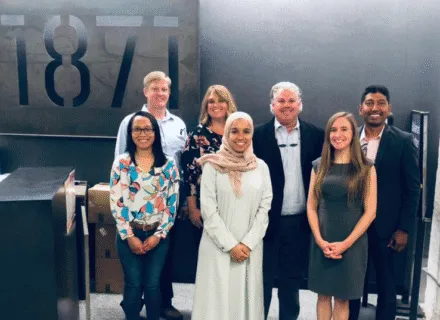
Research team with Technical Advisory Panel
Helping communities prepare for autonomous vehicles
Professor Arnab Chakraborty, Professor Lindsay Braun, and PhD student Ouafa Benkraouda are working with the Illinois Department of Transportation to help communities prepare for a future of greater Connected and Autonomous Vehicles (CAVs). The research involves understanding how CAV technologies may impact human behavior and infrastructure decisions, and how local plans can help communities prepare for these changes. The team is employing scenario analysis, a tool for managing uncertainty, to explore a range of CAV-related impacts. The project also involves consultations with state and local practitioners, community residents, technology companies, and elected officials through interviews, surveys, and workshops. The final product—a set of policies and design guidelines—will offer mid-sized regions in Illinois a path to pursue favorable CAV outcomes. The project is supported by a $180,000 grant from the Illinois Center for Transportation.
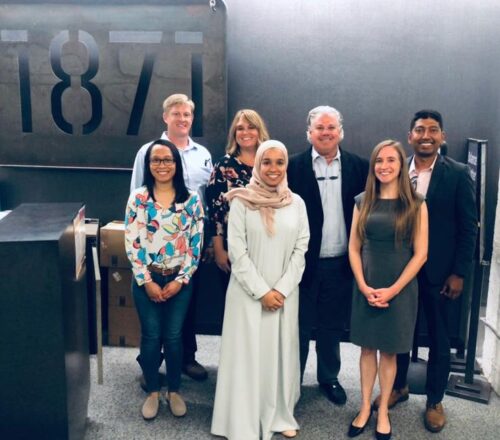
Research team with Technical Advisory Panel
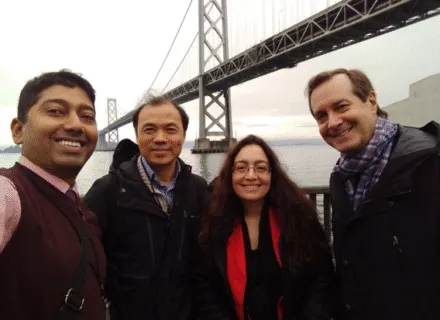
Research team members (from left): Professors Chakraborty, Zhang, and El-Gohary with Coach Glenn near Bay Bridge in San Francisco
Integrating socioeconomic impacts into infrastructure decision-making
Professor Arnab Chakraborty is a co-PI of an interdisciplinary and multi-university research team that is developing an Open Knowledge Network for Civil Infrastructure Systems, led by U of I Civil and Environmental Engineering (CEE) Professor Nora El-Gohary. The project is supported by a Phase 1 Convergence Accelerator grant from the National Science Foundation. Professor Chakraborty’s role focuses on developing assessment measures of the socioeconomic impacts of infrastructure system disruptions and integrating these measures into infrastructure decision-making processes. One goal, for example, is to assist state agencies compare how alternative maintenance or closure decisions may affect access to employment and healthcare opportunities, and whether such decisions may disproportionately affect vulnerable populations. The research will significantly enrich existing approaches that rely largely on immediate project costs. PhD student Wataru Morioka is currently working as the research assistant on this project.
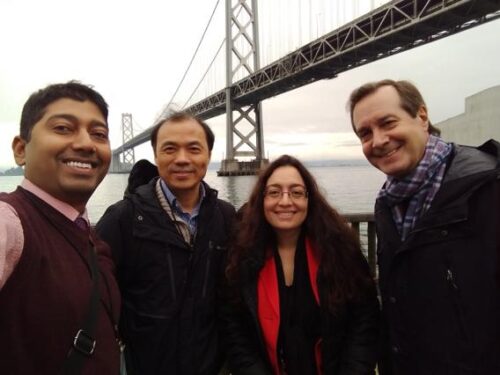
Research team members (from left): Professors Chakraborty, Zhang, and El-Gohary with Coach Glenn near Bay Bridge in San Francisco
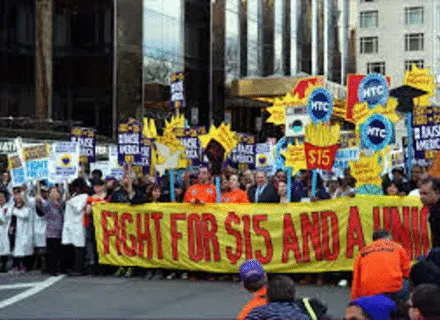
How do we make work pay?
Research by Professor Marc Doussard
The middle class has been shrinking for longer than most Americans have been alive. For decades policymakers insisted that cities and states and even the Federal government lacked the power to improve jobs, pay, and livelihoods. Today economic justice movements rooted in U.S. cities show that there is nothing inevitable about inequality. Cities that once deferred to Federal policy now lead the way on making work pay and providing economic opportunity for citizens. Common policy interventions supporting workers include the $15 minimum wage, wage theft laws, paid time off, fair workweek ordinances, and anti-harassment laws. Increasingly cities complement action on low-wage work with broader support for human development—support evident in basic-income trial programs, community land trusts, universal prekindergarten programs, and a range of bold experiments to support equity.
Professor Doussard works in partnership with community organizations, workers, and policy organizations to answer the simple questions: Why is this happening, and where will movements for economic justice go? These questions are answered through a number of data sources—legislative statistics, content analysis, interviews, participant observation—drawn from his work on behalf of low-wage workers. Professor Doussard’s research shows that citizens have developed a new form of advocacy that reverses long-held expectations about the barriers to working-class communities and communities of color winning change at City Hall. The key to understanding this advocacy is to focus on the multi-city, multi-issue networks advocates have built. Focusing on these networks moves us away from understanding urban politics one city at a time and towards understanding how citizens have rebuilt their advocacy movements to meet the challenges of economic globalization.

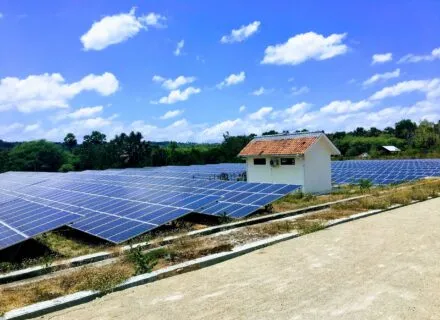
Solar panels in Indonesia
Renewable energy and the challenges of land use in Southeast Asia
Professor Sean Kennedy
Southeast Asia has abundant renewable energy resources yet difficulties in acquiring land pose significant barriers to project development. To facilitate renewable energy expansion, several national governments have relaxed land use regulations by expediting permitting and lowering land acquisition costs for developers. While these measures may support renewable energy development, they also risk displacing existing land uses and livelihoods. This collaborative project, funded by the Institute of Sustainability, Energy, and the Environment, compares how three emerging renewable energy hotspots—Indonesia, Vietnam, and the Philippines—are adapting land use regulations to facilitate large-scale renewable energy development. The findings are intended to inform policy recommendations that facilitate continued renewable energy development while ensuring protections for existing land uses and livelihoods.

Solar panels in Indonesia
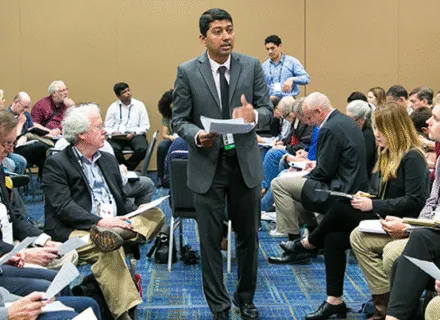
Professor Chakraborty leading a scenario planning training session at the National Planning Conference
Understanding effect of regional scenario efforts on local plans and decisions
Professor Arnab Chakraborty and PhD student Stephen Sherman are researching how regional scenario efforts can shape local plans and decisions. The research involves document analysis of scenario efforts and selected plans in multiple U.S. regions, plus key informant interviews with regional planning officials and local stakeholders. The research is supported by a Lincoln Institute of Land Policy grant and one of the project’s goals is to advance the work of the Consortium for Scenario Planning, where Professor Chakraborty is a board member.
Professor Chakraborty’s work on scenario planning is part of the core resource in the American Planning Association’s Research KnowledgeBase on this subject, and the Federal Highway Administration’s transportation planning guide “Next Generation Scenario Planning” credits one of his articles as the “the backbone.” DURP faculty member Dustin Allred’s work with Professor Chakraborty assessing Sacramento region’s Blueprint Plan is one of the few systematic evaluations of a regional plan and applications of scenario planning. Their article inspired an article in The Sacramento Bee highlighting the plan’s shortcomings and an editorial defending the plan.
Key Publications
- Chakraborty, A., Kaza, N., Knaap, G. J. and Deal, B., (2011) “Robust plans and contingent plans: The promise of scenario planning,” Journal of the American Planning Association 77:3 251-266.
- Chakraborty, A., and McMillan, A. (2015). Scenario Planning for Urban Planners: Toward a Practitioner’s Guide. Journal of the American Planning Association, 81(1), 18-29.
- Allred, D., and Chakraborty, A. (2015). Do Local Development Outcomes Follow Voluntary Regional Plans? Evidence from Sacramento Region’s Blueprint Plan. Journal of the American Planning Association, 81(2), 104-120.
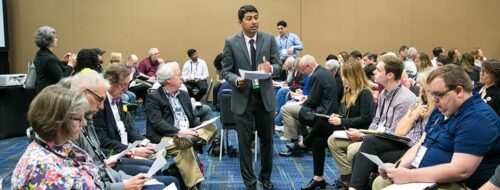
Professor Chakraborty leading a scenario planning training session at the National Planning Conference

Who pays for bed bug infestations?
Research by Professors Daniel Schneider and Andrew Greenlee
Bed bug infestations are an emerging cause of health disparities in American cities and a threat to housing security and affordability. Cities, tenant organizations, and public health agencies are all seeking policy that can reduce bed bug infestations. Municipalities have responded to bed bug infestations in a variety of ways, ranging from doing nothing to crafting comprehensive policies addressing multiple aspects of risk. Understanding the relation between landlord and tenant behavior and infestation is necessary to inform best practices for policies establishing tenant and landlord rights and responsibilities for bed bug control. Having more information on differential impacts based upon tenant income is crucial for effective evaluation of control strategies, such as disclosure.
Working in partnership with public health, social science, and natural science researchers, as well as pest control and housing practitioners, we are modeling the policy impacts of local bed bug regulations, as well as the social and economic determinants of bed bug infestations. We are also using ethnographic methods to examine the complex relations between landlords, tenants, and bed bugs in order to specify how policy impacts are likely to accrue differently to renters on the basis of their income.

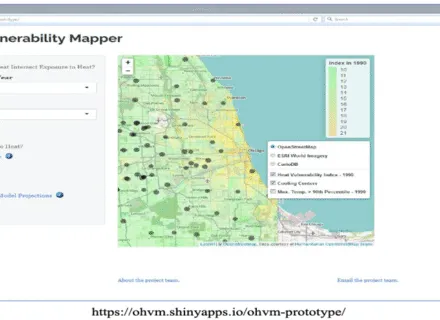
An early prototype of the vulnerability mapping tool for Chicago
Responding to extreme heat in vulnerable communities
Extreme heat events are getting more frequent and intense around the world. Responses to extreme heat are often limited and primarily focused on addressing exposure, with less attention paid to the underlying social vulnerabilities that strongly influence the outcomes. This project includes research in multiple cities around the world including Chicago, Mumbai, and Agra. The research team includes Professor Arnab Chakraborty, Professor Bev Wilson (now at the University of Virginia), and PhD student Xijing Li, and was originally supported by a grant from the Lincoln Institute of Land Policy. An Illinois News Bureau research profile is available here.
Publications
- Wilson, Bev, and Arnab Chakraborty. “Mapping vulnerability to extreme heat events: lessons from metropolitan Chicago.” Journal of Environmental Planning and Management 62.6 (2019): 1065-1088.
- Chakraborty, Arnab, and Xijing Li. Exploring the heterogeneity in relationship between heat exposure and land development in Mumbai, India: A framework to address urban vulnerability in developing megacities (Working Paper).
- Li, Xijing, and Arnab Chakraborty. Rapid urbanization & urban heat island effect: A multi-scale assessment of two fast-growing cities in contemporary India (Working Paper).
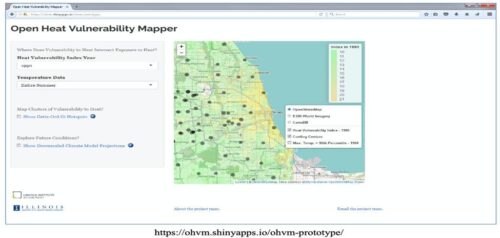
An early prototype of the vulnerability mapping tool for Chicago
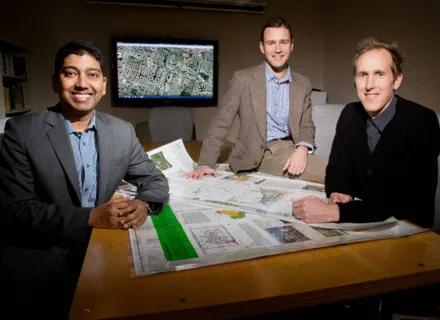
DURP faculty members Chakraborty and Allred with PhD alum Robby Boyer
Exploring the role of zoning in affordable housing
Professor Arnab Chakraborty’s empirical research has highlighted negative social, economic, and environmental consequences of land use plans and policies. Focused on the most vulnerable, his work has identified racial motivations behind exclusionary zoning, negative impact of zoning restrictiveness on foreclosure risk, and benefits of housing diversity in building a stable community. His research on zoning restrictiveness has been funded by NSF and has received national attention. One of his papers was the centerpiece of a dedicated forum in the journal Housing Policy Debate and his profile in the field earned him an invitation to publish a commentary in the latest issue of JAPA on the hot topic of zoning reform.
Key Publications
- Chakraborty, A. (2020). Calls to End All Single-Family Zoning Need More Scrutiny. Journal of the American Planning Association, 86(1), 123-124.
- Chakraborty, A., and McMillan, A. (2018). Is Housing Diversity Good for Community Stability? Evidence from the Housing Crisis. Journal of Planning Education and Research, 0739456X18810787.
- Chakraborty, A., Allred, D. and Boyer, R. 2013. “Zoning Restrictiveness and Housing Foreclosures: Exploring a New Link to the Subprime Mortgage Crisis” – Housing Policy Debate 23:2 431-457.
- Chakraborty, A., Knaap, G. J., Nguyen, D., and Shin, J. H., (2010) “The effects of high-density zoning on multifamily housing construction in the suburbs of six U.S. metropolitan areas,” Urban Studies 47:2 437-451.
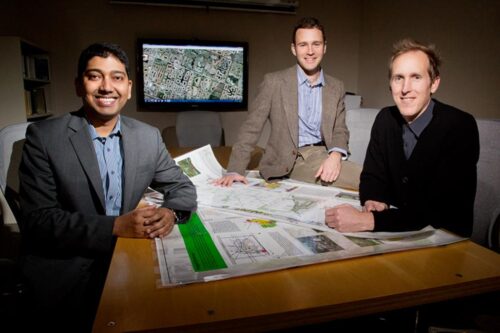
DURP faculty members Chakraborty and Allred with PhD alum Robby Boyer

Can legal cannabis deliver economic equity?
Research by Professor Marc Doussard
Legalizing marijuana provides the rare opportunity for states to design a new industry from scratch. Debates about legalization typically focus on tax revenue and other narrow measures of economic impact. States, however, use a more subtle and potentially transformative set of powers when they legalize. Small regulatory details, such as requirements that dispensaries sell their own product, or allowances for agricultural production, shape who enters the emergent cannabis industry and how businesses compete for consumers. Now that legislatures accountable to diverse electorates have begun to legalize cannabis, the potential for legalization to counteract deeper economic inequalities grows. For example, the Illinois legislature’s 2019 legalization bill contained measures to expunge drug-related felonies, to support labor-friendly employers, and to earmark tax revenues for reinvestment in communities with high incarceration rates.
Professor Doussard uses whatever data he can get my hands on to ask how and under what conditions legal cannabis can support the economic development of cities and regions. His focus is in particular on low-income communities and communities that suffered disproportionately from the war on drugs. Throughout, he focuses on the simple, important reality that legalization provides states and organized groups of citizens the rare and valuable opportunity to set the trajectory of a new industry.
